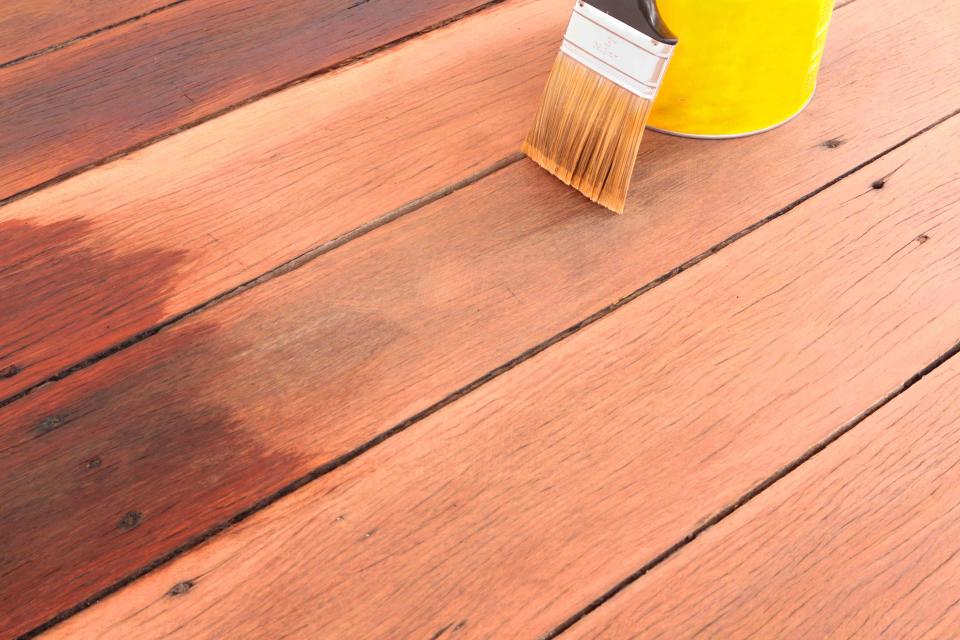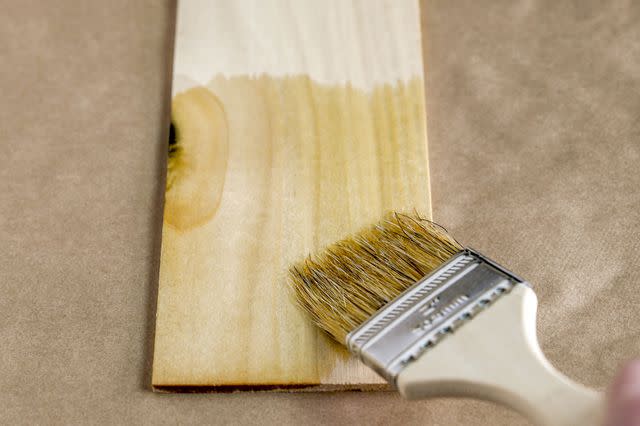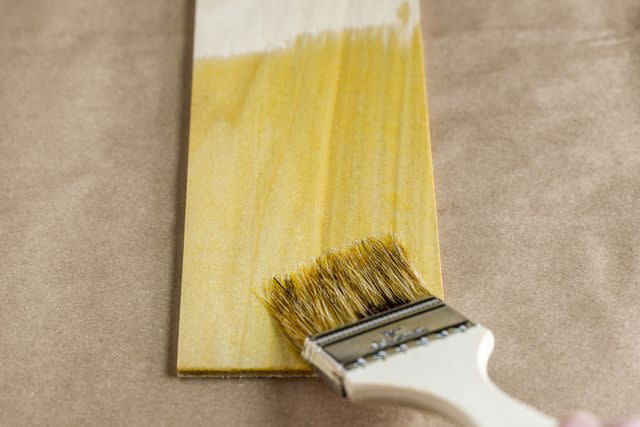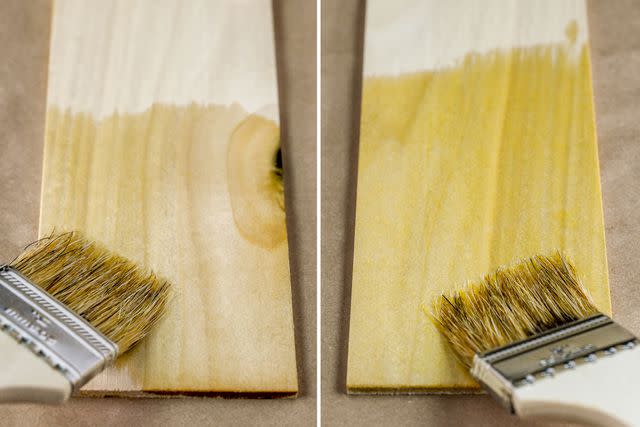Tung Oil vs. Linseed Oil Comparison Guide
Learn the key differences between these common wood finishes

Getty Images / pglover
Reviewed by Johnathan Brewer
To the untrained eye, tung oil and linseed oil seem very similar. Both oils will leave wood with a beautiful, natural-looking finish; they are easy to apply and aren't too far off in price. So, how do you choose between tung oil vs. linseed oil? Which one is better for your wood furniture refinishing project?
Both are nature-based oils pressed from the seeds of plants, so they're non-toxic and food-safe, but tung oil dries quicker and leaves a matte appearance, while linseed oil takes longer to cure and has more of a shiny appearance.
This comprehensive guide will help you understand the many differences between tung and linseed oil, their strengths and weaknesses, and clarify which oil is best for specific applications.
What Is Tung Oil?

The Spruce / Adrienne Legault
Tung oil is drying or finishing oil from the tung tree's seeds (Vernicia fordii). It hardens when exposed to air, looking transparent, wet, or wrinkled (raw tung oil). Raw tung oil is boiled to prevent the wrinkled look. It dries clear, has high water resistance, and lasts long.
What Is Linseed Oil?

The Spruce / Adrienne Legault
Linseed oil is another drying or finishing oil, also called flaxseed oil, since it is derived from the seeds of the flax plant (Linum usitatissimum). This colorless or yellowish oil takes a long time to dry. The seeds can be warm-pressed, which gives a higher yield, or cold-pressed, which results in fewer impurities. Its most significant advantages are that it is inexpensive and has a shiny sheen.
Tung Oil vs. Linseed Oil: Major Differences

The Spruce / Adrienne Legault
Tung Oil (L) vs. Linseed Oil (R)Note there are many impure versions of these two natural oils. The following chart lists the qualities of the oils based on the purest forms. Always pay close attention to the additives in your specific product and follow proper safety measures for application and use.
| Pure Tung Oil | Raw Linseed Oil |
Source | Extracted from the nuts of the tung tree | Extracted from flaxseeds |
Color | Dries clear, but will add slight color to lighter woods | Dries slightly yellow, but will worsen over time |
Dry/Cure Time | Two to three days | Several weeks |
Water-Resistance | High | Low |
Durability | High | Low, prone to scratching |
Cost | High | Average |
Sheen | Matte | Satin |
Maintenance | Requires regular reapplication | Requires regular reapplication |
Toxicity | Non-toxic to humans and pets in pure form, once fully cured | Non-toxic to humans and pets in pure form, once fully cured |
Food safety | Food-safe in pure form, once fully cured | Food-safe in pure form, once fully cured |
Varieties of Tung Oil
Pure tung oil: Pure tung oil is incredibly thick, which makes application slow and curing times even slower. However, in its pure state, it's non-toxic and food-safe.
Tung oil finish or varnish blend: Tung oil with additives is considered a blend. They may be mixed with resins to add durability and shine, drying agents to speed drying time, or solvents that make application easier. These products are no longer considered "non-toxic" or "food-safe."
Polymerized or tung wiping varnish: Polymerized tung oil has been heat-treated, which aids in drying. When varnish additives are added to the polymerized tung oil, it can be used as a wiping varnish, which means you can wipe it on, which is a straightforward application process.
Warning
Because different tung oil types vary by ingredients, each one may call for slightly different application techniques, drying times, and safety measures. Pay close attention to product labels before use.
Varieties of Linseed Oil
Raw linseed oil: The purest form of the oil makes for an excellent natural finish, but it takes a significant amount of time (several weeks between coats). Because of this, it's a pretty impractical product for everyday DIYers. The solution? Boiled linseed oil.
Boiled linseed oil: Boiled linseed oil isn't technically boiled—anymore. In earlier days, when it was first processed, the oil was boiled, and lead was added. This allowed the several-week cure time of raw linseed oil to be drastically shortened, making the product more useful on a broader scale. However, lead is toxic. Now, "boiled" linseed oil contains safer metallic or petroleum-based driers to help speed up drying. These additives still emit VOCs and are not food-safe but are safer than lead-containing products.
Polymerized linseed oil. Unlike boiled linseed oil, polymerized linseed oil is heated for an extended period while starved of oxygen, which causes a polymeric reaction to occur. Once the oil is polymerized, it's more viscous but has drastically shorter drying times. This process changes the linseed oil on a molecular level but remains additive-free, which keeps the oil free of VOCs.
What Are VOCs?
VOCs is the common shorthand name for volatile organic compounds. These chemicals have a high vapor pressure at room temperature, causing them to off-gas after application. For this reason, items with VOCs require more time for off-gassing before they should be used.
Factors to Consider When Choosing Between Tung Oil vs. Linseed Oil
Appearance
Tung oil: Pure tung oil has a beautiful matte finish that makes the wood more striking without drastically tinting or yellowing the wood's natural hue. Impure tung oil products may add more color to the wood. Tung oils with additives can vary in appearance and sheen.
Linseed oil: Linseed oil lends an amber hue to wood that will turn yellow over time. This visual effect is much more noticeable in lighter woods such as birch and maple. Once dry, linseed oil has a satin sheen.
Best for appearance: Tung oil
The clear, matte finish of tung oil makes it a go-to for those who want a natural finish with protective qualities.
Water Resistance
Tung oil: Tung oil is water resistant, preventing water molecules from seeping into the wood's grain. This is due to the curing process, during which the tung oil reacts with the oxygen in the air to form a hard protective barrier on the outside of the wood.
Linseed oil: Linseed oil has much less water resistance than tung oil. While the oil is hydrophobic (like all oils), it is susceptible to water damage. This means it may slightly protect the wood beneath from spills and water exposure, but the finish can be damaged.
Best for water resistance: Tung oil
Regarding water resistance, tung oil is superior to linseed oil and will offer much more water protection in any application.
Care and Cleaning
Tung oil: Tung oil can easily be wiped clean with a damp cloth. But, for more intense cleaning, water-vinegar mixtures can be used, as well as oil soaps and even some mild household cleaning products. Always ensure the products are non-bleachable and test on hidden areas before completing their application.
Linseed oil: Linseed-oiled surfaces can be wiped with a slightly damp cloth. However, too much water can damage the finish. A mixture of turpentine, vinegar, and linseed oil is recommended for more intense cleaning. The turpentine and vinegar will lift heavy-duty dirt, while the linseed oil protects and maintains the finish.
Best for care and cleaning: Tung oil
Properly applied tung oil is much easier to clean than linseed oil, as it can be cleaned with readily available commercial cleaning products and is much more forgiving when washed with water.
Durability and Maintenance
Tung oil: Pure tung oil creates a durable wood finish when properly applied. The finish soaks into the wood and cures to form a highly water- and scratch-resistant barrier. To maintain durability and water resistance, finished tung oil items should be cleaned and recoated regularly if they are being used regularly.
Linseed oil: Wood finished with linseed oil is much more durable than raw wood, but linseed oil as a finish doesn't rank high on the durability scale. Wood finished in linseed oil is prone to scratching and water damage. This is exaggerated if the finish isn't maintained and regularly recoated, at least once yearly.
Best for durability and maintenance: Tung oil
While tung and linseed oil require maintenance and regular recoating for peak durability, tung oil is far more water-resistant and scratch-resistant than linseed oil. That said, modern varnishes and top coats will offer more durability than both oils.
Application
Tung oil: Pure tung oil is easy to apply and nearly impossible to mess up. Sand the wood until smooth, remove all dust and debris, then flood the surface with the oil. As you see dry spots occur, add more oil. Once the wood no longer absorbs oil, clean the surface with a dry cloth. Allow the oil to cure for several days, then lightly sand and re-coat. Five, six, seven, or more coats can be applied.
Linseed oil: Applying raw linseed oil is similar to tung oil, with some slight differences. After sanding the wood and removing the dust and debris, liberally wipe the linseed oil on the wood, following the grain until the entire surface has been covered. Allow the oil to penetrate the wood for 15 minutes, then wipe off the excess. If the surface has dried considerably over 15 minutes, allow the wood to absorb more oil for another 15 minutes before wiping clean. Apply at least three coats, allowing several weeks of cure time between coats and buffing with grade 0000 steel wool between coats.
Best for application: Tung oil
Tung oil is possibly the easiest wood finish to apply, and the several weeks between coats of raw linseed oil make it an impractical finish option for many people. Boiled and polymerized linseed oil will reduce the curing time, but remember that these oils have different qualities and safety levels.
Tip
If you're unsure if the oil has cured, check if it is tacky. If so, it needs more time. If you can't tell, buildup on your sandpaper will be a dead giveaway that it needs more time to cure.
Cost
Tung oil: Pure tung oil costs around $25 to $30 per quart, while impure versions with additives can be found for lower prices.
Linseed oil: A quart of raw linseed oil will run you under $20, while popular alternatives, such as boiled linseed oil, can be found for as low as $13 per quart.
Best for cost: Linseed oil
Raw linseed oil is almost always less expensive than pure tung oil, while popular alternatives and impure versions are more competitively priced.
Lifespan
Tung oil: While no tung oil finish will stay in perfect condition forever, the finish on items kept inside away from sun and water exposure will last much longer than those left outside. Pay close attention to the surface's water-beading capabilities as well as the richness of the finish, and reapply once the wood looks dried and lackluster.
Linseed oil: Linseed oil should be reapplied at least once a year, sometimes multiple times a year, depending on the volume of use the surface sees. Because linseed oil isn't recommended for outdoor use, it should never be exposed to regular sun or water.
Best for lifespan: Tied
Tung and linseed oil (like most oil finishes) need regular reapplication to look their best and offer the most protection. Additionally, both oils will need more regular reapplication depending on the finished surface's use.
When to Use Tung Oil vs. Linseed Oil
When comparing pure tung oil and raw linseed oil, tung oil beats linseed oil on nearly every front. The appearance is generally better and less yellowed; it's easier to maintain, more durable, and takes less time to apply.
However, if cost is a factor, raw linseed oil is cheaper than pure tung oil and still makes for a quality natural finish, especially if you prefer satin over matte.
| Pure Tung Oil | Raw Linseed Oil |
Regularly used furniture pieces | Yes | No |
Boat decks | Yes | No |
Musical instruments | Yes | No |
Ornamental furniture pieces | Yes | Yes |
Countertops | Yes | No |
Butcher blocks | Yes | Maybe |
Wooden bowls and spoons | Yes | Maybe |
As a touch-up oil | Yes | Yes |
Wood flooring | Yes | Maybe |
Frequently Asked Questions
Which is better, linseed or tung oil?
Tung oil performs better than linseed oil in many cases regarding water resistance, durability, remaining clear, and application. However, linseed oil is cheaper and tends to have a more satin sheen, while tung is less shiny in appearance.
What are the disadvantages of tung oil?
Tung oil is pricier than linseed oil, and if you want to get it to shine, you will need to apply many layers (at least five) to get it to shine like linseed oil.
What is the best oil to seal wood with?
A blend of tung oil and linseed oil with other additives is called Danish oil. It's favored by woodworkers for its sealing abilities, varnish, and shine.
What is tung oil best for?
Tung oil works well on all unfinished or weathered wood, wood furniture, boat decks, flooring, cabinetry, countertops, and wood toys and instruments. It also works well on concrete floors, stone, brick, and bamboo.
Read Next: How to Waterproof Wood: 3 Methods
Read the original article on The Spruce.

